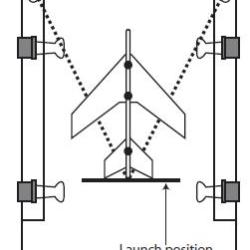Source Institutions
Source Institutions
Add to list Go to activity
Activity link broken? See if it's at the internet archive

In this activity, learners discover how NASA engineers develop experimental aircraft. Learners will use geometry and algebra to design, construct, and test an experimental wing to achieve maximum distance using a portable glider catapult. This lesson plan includes background information, key vocabulary and definitions, blackline masters, extensions including an instructional technology activity, and resources.
- 30 to 45 minutes
- 1 to 2 hours
- $10 - $20 per group of students
- Ages 11 - 14
- Activity, Experiment/Lab Activity, Lesson/Lesson Plan, Model
- English
Quick Guide
Materials List (per group of students)
- 20 straight pins
- 8 small binder clips
- Calculator
- Masking tape
- Student worksheets (pages 13-21 of PDF)
- 10 meat trays (suggestion: 28 cm X 23 cm - size 12)
- Meter stick or measuring tape
- 4 scissors (optional: plastic knife, box cutter)
- Fine sand paper or emery board
- 2 thumbtacks
- Rubber band (size 64)
- Cardboard (28 cm X 40 cm)
- 2 wooden rulers or paint sticks
Subjects
-
Earth and Space Science
-
Astronomy
- Probes, Satellites and Spacecraft
-
Earth Structure
- Atmosphere
-
Astronomy
-
Engineering and Technology
-
Engineering
- Aerospace Engineering
- Transportation Engineering
-
Engineering
-
Mathematics
-
Algebra
- Equations and Inequalities
-
Data Analysis and Probability
- Data Analysis
- Data Collection
- Data Representation
-
Geometry
- Plane Geometry
-
Measurement
- Units of Measurement
- Size and Scale
- Number and Operations
-
Algebra
-
Physical Sciences
-
Energy
- Work and Machines
- Motion and Forces
-
Energy
-
The Nature of Science
-
The Scientific Process
- Asking Questions
- Conducting Investigations
- Gathering Data
- Formulating Explanations
- Communicating Results
-
The Scientific Process
-
The Nature of Technology
-
The Design Process
- Research and Development
- Invention and Innovation
- Problem Solving
- Troubleshooting and Maintenance
-
The Design Process
Informal Categories
- Model Building
- Transportation
Audience
To use this activity, learners need to:
- see
- read
- be mobile
- touch
Learning styles supported:
- Involves teamwork and communication skills
- Uses STEM to solve real-world problems
- Involves hands-on or lab activities
Other
Components that are part of this resource:
Includes alignment to state and/or national standards:
This resource is part of:
Access Rights:
- Free access
By:
- NASA Center for Distance Learning, Office of Education at NASA’s Langley Research Center
Rights:
- All rights reserved, National Aeronautics and Space Administration,
